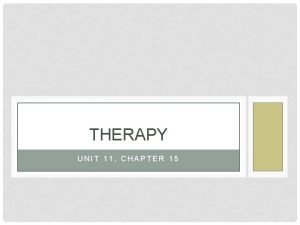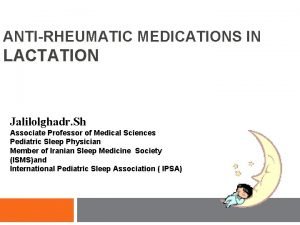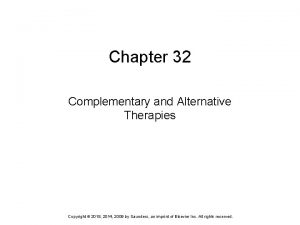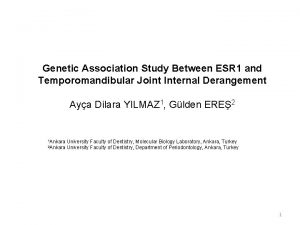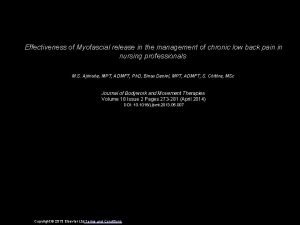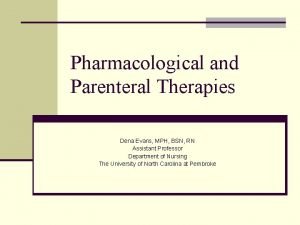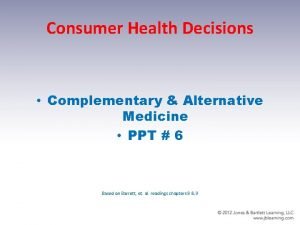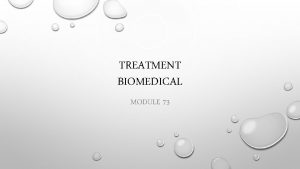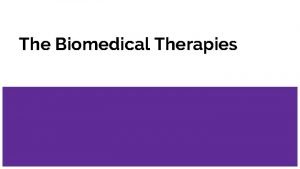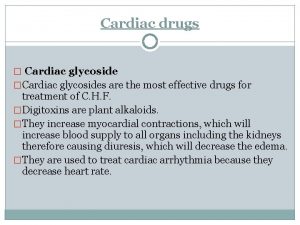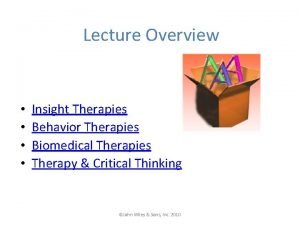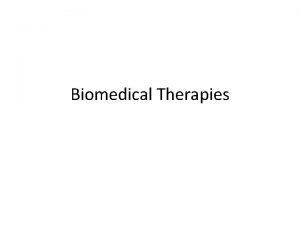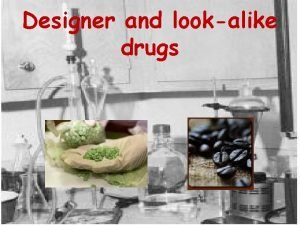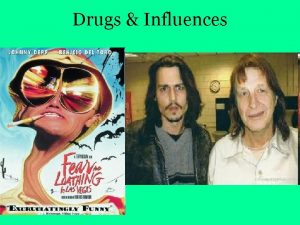Cardiac Disease and Therapies Main Cardiac Therapies drugs











- Slides: 11

Cardiac Disease and Therapies Main Cardiac Therapies: § drugs § pacemaker § defibrillation § coronary artery bypass grafting § coronary angioplasty § artificial heart valves 18. 1. 1 Cardiac Therapies Unit C 18. 1 Maintaining cardiovascular and monitoring equipment Module 279 19 C Medical Instrumentation II © dr. Chris R. Mol, BME, NORTEC, 2017

Main Cardiac Diseases Hypertensive heart disease High blood pressure may overburden the heart and blood vessels and cause disease. Ischemic heart disease Heart ailments caused by narrowing of the coronary arteries and therefore a decreased blood supply to the heart. Inflammatory heart disease Inflammation of the heart muscle or surrounding tissues may be caused by toxic or infectious agents. Rheumatic heart disease is caused by one or more attacks of rheumatic fever, which then do damage to the heart, particularly the heart valves. Rheumatic fever usually occurs in childhood, and may follow an infection. The valves are sometimes scarred so they do not open and close normally. © dr. Chris R. Mol, BME, NORTEC, 2017 Cardiac Therapies

Cardiac Medications you don’t need to know the info on this slide for your tests. It is here to illustrate the many different approaches that are being tried to remedy heart disease. There a variety of drugs prescribed for patients with heart disease. Most patient take these drugs for the rest of their life. Some drugs commonly prescribed for heart disease include: • ACE Inhibitors aim to widen the arteries to lower blood pressure and make it easier for the heart to pump blood. • Aldosterone Inhibitor can be prescribed to reduce the swelling and water build-up caused by heart failure. • Angiotensin II Receptor Blockers are used to decrease blood pressure in people with heart failure. • Beta-Blockers block the effects of adrenaline and cause the heart to beat more slowly and with less force, lowering blood pressure. • Calcium Channel Blockers affect the movement of calcium in the cells of the heart and blood vessels. As a result, the drugs relax blood vessels and increase the supply of blood and oxygen to the heart, while reducing its workload. There a lot of approaches to diminish the burden on the heart. The cardiologist works out with the patient what works best in his (/her) case. © dr. Chris R. Mol, BME, NORTEC, 2017 Cardiac Therapies

Cardiac Medication: example © dr. Chris R. Mol, BME, NORTEC, 2017 Cardiac Therapies

Pacemaker In cardiac arrhythmia, also known as irregular heartbeat the heartbeat is irregular, too fast, or too slow. A heartbeat that is too fast - above 100 beats per minute in adults - is called tachycardia and a heartbeat that is too slow - below 60 beats per minute - is called bradycardia. Many arrhythmias have no symptoms. When symptoms are present these may include palpitations or feeling a pause between heartbeats. Most arrhythmias are not of serious concern. A pacemaker is a medical device which uses electrical impulses, delivered by electrodes to regulate the beating of the heart. The primary purpose of a pacemaker is to maintain an adequate heart rate, either because the heart's natural pacemaker is not fast enough, or because there is a block in the heart's electrical conduction system. We will discuss this further in the future lecture on pacemakers. © dr. Chris R. Mol, BME, NORTEC, 2017 Cardiac Therapies

Defibrillator The heart is able to pump blood effectively only when contractions of all its muscle fibres are precisely synchronized. In Ventricular Fibrillation (VF), the normal rhythmic ventricular contractions are replaced by rapid, irregular twitching that results in ineffective and severely reduced pumping. If normal rhythm is not restored quickly, death is imminent. Getting the heart out of this situation is called defibrillation. This can often be achieved by applying an electric shock to the heart to depolarize the myocardium and stop the uncoordinated contractions. The SA node can then resume normal function, and sinus rhythm can be restored. © dr. Chris R. Mol, BME, NORTEC, 2017 Cardiac Therapies

Coronary Artery Bypass Grafting Coronary artery bypass grafting (CABG) is a type of surgery that improves blood flow to the heart. Surgeons use CABG to treat people who have severe coronary heart disease (CHD). CHD is a disease in which a waxy substance called plaque builds up inside the coronary arteries. These arteries supply oxygen-rich blood to your heart. Over time, plaque can harden or rupture (break open). Hardened plaque narrows the coronary arteries and reduces the flow of oxygen-rich blood to the heart. This can cause chest pain or discomfort called angina. If the plaque ruptures, a blood clot can form on its surface. A large blood clot can mostly or completely block blood flow through a coronary artery. This is the most common cause of a heart attack. CABG is a treatment for CHD. During CABG, a healthy artery or vein from the body is connected to the blocked coronary artery. The grafted artery or vein bypasses (that is, goes around) the blocked portion of the coronary artery. This creates a new path for oxygen-rich blood to flow to the heart muscle. Surgeons can bypass multiple coronary arteries during one surgery. © dr. Chris R. Mol, BME, NORTEC, 2017 Cardiac Therapies

Coronary Angioplasty X-ray images before and after angioplasty Coronary angioplasty is a treatment to widen narrowed sections of the heart (coronary) arteries by using a balloon and a stent attached to a catheter. A catheter is a thin, flexible tube which is inserted into a coronary artery via the large blood vessels. balloon catheter The balloon at the tip of the catheter is blown up at the narrowed section of artery to force it wider. A small tube (a stent) is left in place to keep the artery widened © dr. Chris R. Mol, BME, NORTEC, 2017 Cardiac Therapies

Coronary Angioplasty Heart Catheterization Lab (Philips) © dr. Chris R. Mol, BME, NORTEC, 2017 Cardiac Therapies

Artificial Heart Valves Heart valves are important for the normal physiological functioning of the human heart. Natural heart valves can become dysfunctional for a variety of pathological causes. When one of the four heart valves malfunctions, the medical choice may be to replace the natural valve with an artificial valve. This requires open-heart surgery. An artificial heart valve is a device implanted in the heart of a patient with a disease of the heart valves. E. g. the valve may not fully open, causing diminished blood flow, or may not fully close, causing back flow of blood (in the wrong direction). © dr. Chris R. Mol, BME, NORTEC, 2017 Cardiac Therapies

END The creation of this presentation was supported by a grant from THET: see https: //www. thet. org/
 Systematic desensitization therapy
Systematic desensitization therapy Bharathi viswanathan
Bharathi viswanathan Disease modifying antirheumatic drugs
Disease modifying antirheumatic drugs Chapter 32 complementary and alternative therapies
Chapter 32 complementary and alternative therapies Psychodynamic and humanistic therapies have in common
Psychodynamic and humanistic therapies have in common Pvu
Pvu Bodywork and movement therapies
Bodywork and movement therapies Pharmacological and parenteral therapies
Pharmacological and parenteral therapies Complementary and alternative medicine ppt
Complementary and alternative medicine ppt What is the central idea of this passage?
What is the central idea of this passage? Module 73 the biomedical therapies
Module 73 the biomedical therapies What is biomedical therapy
What is biomedical therapy
